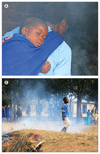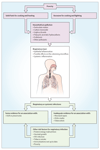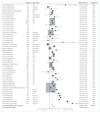Respiratory risks from household air pollution in low and middle income countries
- PMID: 25193349
- PMCID: PMC5068561
- DOI: 10.1016/S2213-2600(14)70168-7
Respiratory risks from household air pollution in low and middle income countries
Abstract
A third of the world's population uses solid fuel derived from plant material (biomass) or coal for cooking, heating, or lighting. These fuels are smoky, often used in an open fire or simple stove with incomplete combustion, and result in a large amount of household air pollution when smoke is poorly vented. Air pollution is the biggest environmental cause of death worldwide, with household air pollution accounting for about 3·5-4 million deaths every year. Women and children living in severe poverty have the greatest exposures to household air pollution. In this Commission, we review evidence for the association between household air pollution and respiratory infections, respiratory tract cancers, and chronic lung diseases. Respiratory infections (comprising both upper and lower respiratory tract infections with viruses, bacteria, and mycobacteria) have all been associated with exposure to household air pollution. Respiratory tract cancers, including both nasopharyngeal cancer and lung cancer, are strongly associated with pollution from coal burning and further data are needed about other solid fuels. Chronic lung diseases, including chronic obstructive pulmonary disease and bronchiectasis in women, are associated with solid fuel use for cooking, and the damaging effects of exposure to household air pollution in early life on lung development are yet to be fully described. We also review appropriate ways to measure exposure to household air pollution, as well as study design issues and potential effective interventions to prevent these disease burdens. Measurement of household air pollution needs individual, rather than fixed in place, monitoring because exposure varies by age, gender, location, and household role. Women and children are particularly susceptible to the toxic effects of pollution and are exposed to the highest concentrations. Interventions should target these high-risk groups and be of sufficient quality to make the air clean. To make clean energy available to all people is the long-term goal, with an intermediate solution being to make available energy that is clean enough to have a health impact.
Copyright © 2014 Elsevier Ltd. All rights reserved.
Conflict of interest statement
Declaration of interests JG reports personal fees from GlaxoSmithKline and personal fees from Novartis. He is a member of the UK Government’s Committee on the medical effects of air pollution and is co-chair of the Royal College of Physicians working party on the long-term effects of air pollution. SBG and KM received grants from Joint Global Health Trials to carry out an interventional trial in Malawi. The other authors report no competing interests.
Figures











Comment in
-
Breaking new ground to promote change.Lancet Respir Med. 2014 Oct;2(10):781. doi: 10.1016/S2213-2600(14)70178-X. Epub 2014 Sep 2. Lancet Respir Med. 2014. PMID: 25193348 No abstract available.
-
Household air quality in high-income countries: forgotten but not gone.Lancet Respir Med. 2014 Oct;2(10):781-3. doi: 10.1016/S2213-2600(14)70183-3. Epub 2014 Sep 2. Lancet Respir Med. 2014. PMID: 25193350 No abstract available.
-
Household air pollution: a call to action.Lancet Respir Med. 2015 Jan;3(1):e1-2. doi: 10.1016/S2213-2600(14)70288-7. Lancet Respir Med. 2015. PMID: 25593091 No abstract available.
References
-
- Rehfuess E. Fuel for Life: Household Energy and Health. Geneva: World Health Organization; 2006.
-
- WHO. [accessed Aug 18, 2014];The Global Health Observatory. 2014 http://apps.who.int/gho/data/node.main.135?lang=en.
Publication types
MeSH terms
Grants and funding
LinkOut - more resources
Full Text Sources
Other Literature Sources
Medical

